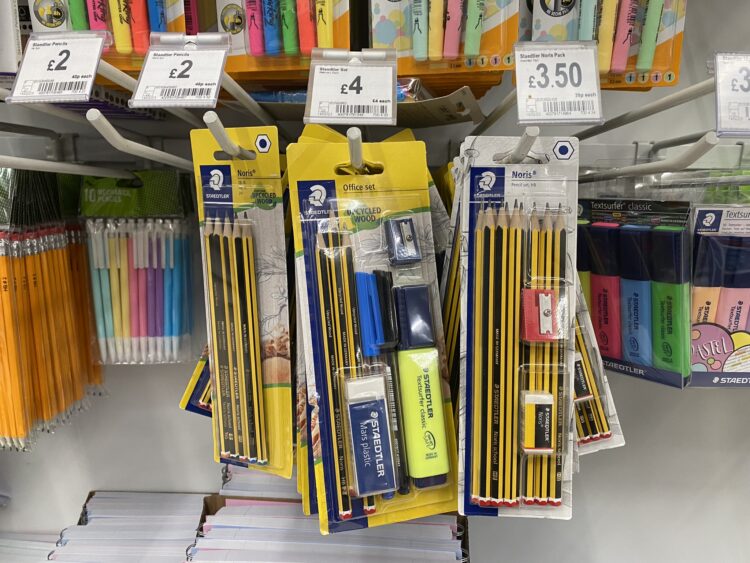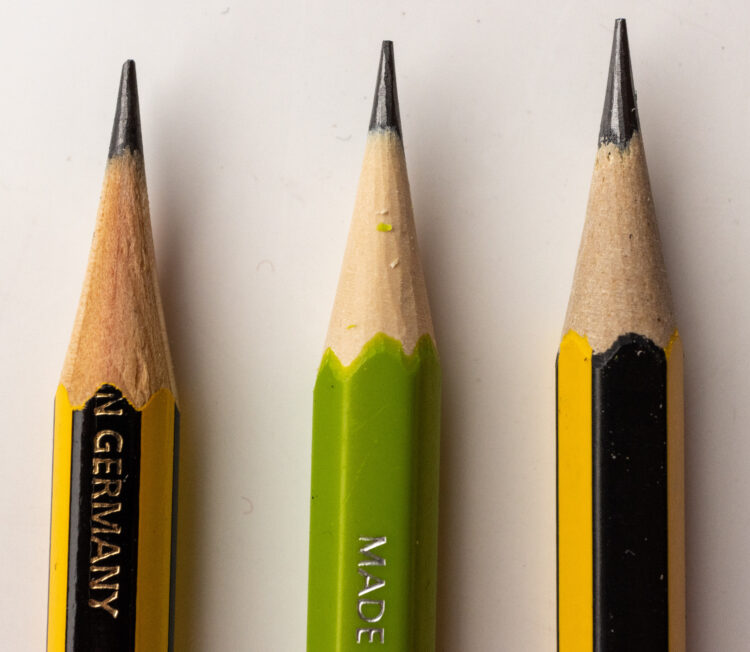A few weeks ago Gunther told a few pencil friends, including me, that Staedtler’s Noris is now made from upcycled wood. Upcycled Wood is the material formerly known as Wopex. These pencils are extruded and use a wood-plastic composite instead of wood.
Wood-plastic composites were invented in the 1960s in Italy, but they are not commonly used for pencils. I assume that no other manufacturer spent as much effort as Staedtler to make wood-plastic composites suitable for pencils.

Well, today I saw the new upcycled Noris for the first time in the UK. Packaging was not consistent, at least not in the supermarket where I saw them:
Packaging variations included:
- upcycled pencils in packaging that indicates it contains upcycled pencils and
- wood-cased pencils in packaging that doesn’t mentioned upcycled wood
- there were also upcycled pencils in the old packaging that didn’t make it explicit that the pencils inside were made with upcycled wood.
I wonder if the new upcycled Noris pencils will change the way schools here in the UK buy pencils. They provide pencils to primary school pupils for free, to be used in the classroom, and most of them buy Noris pencils. Will they be fine with the changes? ..or will they not like the differences? ..or maybe the schools won’t notice the difference? I really wonder…

My first impressions are that, like previous Wopex pencils, the difference between different grades, e.g. 2B vs 2H, is not quite as pronounced in the upcycled Noris as it is in a traditional wood-cased Noris. In the video I link to here I used Leuchtturm paper where the difference between grades is very small. On other paper, like Tomoe River for example here is a huge difference between the different grades.

If you sharpen an upcycled Noris to a very fine point then that point is not as break resistant as the point of a traditional Noris. It is however more break resistant than the point found on earlier Wopex pencils.
On the plus side the upcycled Noris, when sharpened right, has a very nice, waxy-smooth feel to it when writing – the opposite of scratchy.

Find out more about the upcycles Noris in this video:
There are ‘Noris’ and ‘Noris School’ made with upcycled wood with and without ‘upcycled wood’ embossed on them. But I have not seen any ‘Noris School pencil’ examples to date.
I wonder why the lead core composition is different between traditional and upcycled Noris. Not a fan of the old Wopex. My preferred pencil is the Tradition…I hope Staedtler don’t start producing the tradition in upcycled wood.
Than you for your comments.
Robert, if you want to buy any, you can find them on eBay UK and in some online shops.
Kevin, the whole pencil is extruded, so inserting a traditional lead into an extruded ‘encasing’ would be probably be complicated and expensive. Have a look at this video from Staedtler. It’s not with a ‘graphite’ lead but gives an idea who production works: https://www.youtube.com/watch?v=cIj6LjQIDC0
Kevin, I would like to add that there are basicall three kinds of graphite lead: 1. the ceramic-bound, burned lead (the traditional one), 2. the polymer-bound burned lead (like thin leads for mechanical pencils and the lead in the Pentel Black Polymer 999) and 3. the unburned polymer-bound lead. The Wopex/Noris eco/Upcycled Wood has the latter because this pencil is made by co-extrusion without burning.
I saw my first Upcycled Wood Noris pencils the other day in WH Smith – both a five pack with mixed grades, and a 10-pack with sharpener and rubber. Neither of them were marked “Upcycled Wood” on the packaging or the pencils. (As always, WH Smith’s pricing was usurious.)
The packaging wasn’t the same as the packaging you’ve got here. It was the current white and blue packaging, and didn’t mention Upcycled Wood on it at all. The wording on the back was different though.
The Upcycled Wood pencils are noticeably heavier than the wooden ones they replaced. I noticed the weight difference immediately when picking up each pack.
Using my kitchen scales, I weighed a blisterpack of each in HB. The five wooden Norises weighed 29g including packaging; the five Upcycled Wood Norises weighed 51g including packaging – 75% heavier! (I assume the packaging, which was identical for both, weighed the same.)
I haven’t seen any regular Noris yet that are made from “Upcycled Wood”, only the Noris school pencils. As I understand it, the ‘school’ variety are the cheaper version of the Noris. They generally tended to have different/lighter wood than the regular Noris pencils.
I wonder if the two varieties will have any meaningful difference once they’re both made from Wopex material?
I learned from STAEDTLER that the woodcased Noris 120 is still being produced; only for Europe the switch has been made to upcycled wood.
Thank you for this information. I wonder in which markets outside Europe the Noris is a big seller. I always assumed Europe the biggest market for the Noris. I also wonder why Europe gets the upcycled version but other markets don’t.
Hi!
I’ve stumbled across your page while researching this pencil. I’ve now bought the new Noris (in Germany, early 2024) and used it for a while, and here are my observations:
* The surface is a bit rubbery feeling instead of glossy smooth. This has the advantage of a better grip although some may not like it.
* Writing has a slightly waxy feeling, as you already mention. It seems to offer a little bit more resistance on the page than the old Noris, although this is only a nuance. OTOH, the lead feels robust (no crumbling) and seems to wear slowly and evenly, maybe even more so than the old Noris.
* The line is somewhat lighter than the old Noris. This is something I don’t like that much. It is, however, not lighter than some other “HB” graded pencils, like the Koh-I-Noor 1500 (which also is scratchier).
* The new pencil is twice the weight of the old one. This might be bothering some or an advantage to others. From what I understand, it is also more waterproof (the shaft itself) due to its plasticky nature.
* Sharpening is not a problem. There’s no crumbling/splintering wood like on some cheap pencils.
In general, it has advantages and disadvantages. Its main advantage is probably that Staedtler can continue to make a pencil of reasonable quality in Germany at a low price point. For the price, it is not a bad pencil, at least for writing with. Artists probably prefer the Lumograph series over the Noris anyway.
Will I buy it again? Probably not but that doesn’t mean that you shouldn’t try it.
Best
Matt
Thank you for your detailed observations. The supermarkets near Bremen all seem to sell the wood-cased Noris, so I wasn’t sure whether the “Wopex” Noris is currently available in Germany. My experience with this pencil is similar to yours, but for me the upcycled wood usually breaks off near the lead where it is very thin due to sharpening. The graphite core also breaks easily if it is sharpened to a fine point. A rotary sharpener on a blunt setting helps but means you don’t get a very fine tip.